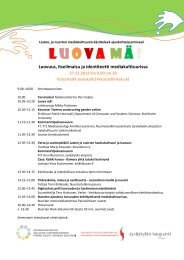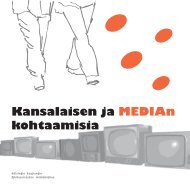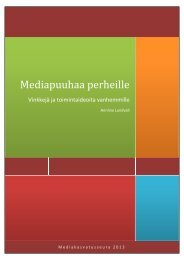teen chat rooms. Developmental Psychology, 42(3), 395-406.Suoninen, A. (2004). Mediakielitaidon jäljillä: lapset <strong>ja</strong> nuoret valikoivia mediakäyttäjiä, Jyväskylä,Jyväskylän yliopisto.Suoninen, A. (2007). Television lastenohjelmatarjonta syksyllä 2006. Liikenne- <strong>ja</strong> viestintäministeriönjulkaisu<strong>ja</strong> 48. Helsinki: Edita.Suzuki, K. Sado, M., Sakamoto, A., Isshiki, N. & Hattori, H. (2004). Violence in Japanese TVprograms: content analysis by using the conding system of the national televisionviolence study. International Congress of Psychology Abstract Book, 28th, Beijing,China, 793, 1-11Suzuki, K. & Calzo, J.P. (2004). The search for peer advice in cyperpace. Journal of AppliedDevelopmental Psychology, 25, 685-698.Syrjälä, H. (2007). Väkivalta lööppijulkisuudessa. Journalismin tutkimusyksikkö. Tiedotusopinlaitos.Tampereen yliopisto. Saatavissa 29.8.2007 osoitteeessa http://www.uta.<strong>fi</strong>/jourtutkimus/Looppitutkimus.pdfSärkelä [Salokoski], T. (2000). Aggression yhteys tietokonepelien pelaamiseen lapsilla. [Aggressionand its relation to computer games playing in childhood.] Pro Gradu -työ,psykologian laitos, Jyväskylän yliopisto.Taloustutkimus oy. (2006). Nuorten rahapelaaminen. 12 – 17-vuotiaiden nuorten rahapelaaminen<strong>ja</strong> peliongelmat – puhelinhaastattelu. Sosiaali- <strong>ja</strong> terveysministeriö.Joulukuu 2006. Haettu 1.6.2007 osoitteesta http://neuvoa-antavat.stakes.<strong>fi</strong>/NR/rdonlyres/A045F52A-66CE-4EDD-BE31-7FFFF42CD4C2/0/nuorten_rahapelaaminen_2007.pdfTarpley, T. (2001). Children, the internet, and other new technologies. Teoksessa Singer,D.G. & Singer, J.L. (Eds). Handbook of Children and the Media. California: SagePublications, Inc.Taskinen, T. (2007). ”Pelasin opeintolainani viidessä minuutissa.” Tutkimus nuorten ongelmapelaajienpelihistoriatarinoista. ProGradu-tutkielma. Kuopion yliopisto. Yhteiskuntatieteellinentiedekunta. Sosiaalityön <strong>ja</strong> Sosiaalipedagogiikan laitos.Taylor, M., Holland, G., & Quayle, E. (2001). Typology of Paedophile Picture Collections. ThePolice Journal, 74( 2), 97 – 107.Tejeiro Salguero, R.A. & Moran, R.M. (2002). Measuring problem video game playing inadolescents. Addiction, 97(21), 1601-1606.Terr, L.C., Bloch, D.A., Michel, B.A. (1999). Children’s symptoms in the wake of challenger: a<strong>fi</strong>eld study of distant-traumatic effects and an outline of related conditions. AmericanJournal of Psychiatry, 156, 1536-1544.Terr, L.C., Bloch, D.A., Michel, B.A. (1997). Children’s thinking in the wake of challenger.American Journalf of Psychiatry, 154, 744-751.Terr, L.C., Bloch, D.A., Michel, B.A. (1996). Children’s memories in the wake of challenger.American Journal of Psychiatry, 153, 618-625.Thomson, K. M. & Haninger, K. (2001). Violence in E-rated video games. Journal of AmericanMediacal Association, 286 (5), 591-598.Tiggermann, M., Gardiner, M. & Slater, A. (2000). “ U would rather be size 10 than havestraight A’s”: a focus group study of adolescent girls’ wish to be thinner. Journal ofAdolescence, 23, 645-659.Tsai, C.C. & Lin, S.S.J. (2001). Analysis of attitudes toward computer networks and internetaddiction of Taiwanese adolesecents. Cyberpsychology Behavior, 4(3), 373-376.Valkenburg, P.M. (2001). Television and the child’s developing imagination. TeoksessaSinger, D.G. & Singer, J.L. (Eds). Handbook of Children and the Media. California:158
Sage Publications, Inc.Valkonen, S, Pennonen, M. & Lahikainen, A. R. (2005). Televisio pienten lasten arjessa.Teoksessa A. R. Lahikainen, P. Hietala, T. Inkinen, M. Kangassalo, R. Kivimäki &F. Mäyrä (toim.). Lapsuus mediamaailmassa. Näkökulmia lasten tietoyhteiskuntaan.Gaudeamus: Tampere.Van den Bulck, J. (2004). Television viewing, computer game playing and internet use andself-reported time to bed and time out of bed in secondary-school children, Sleep,27(1), 101-104.Vandewater, E.A. & Huan, X. (2006). Parental weight status us a moderator of the relationshipbetween television viewing and childhood overweight. Arch Pediatr Adolesc,160, 425-431.Vandewater, E.A. & Lee, J.H., & Shim, M.S. (2005). Family conflict and violent electronicmedia use in school-aged children. Media Psychology, 7, 73-86.Vandewater, E.A., Shim, M. & Caplovitz, A.G. (2004). Linking obesity and activity level withchildrend’s television and video game use. Journal of Adolescence, 27, 71-85.Van-Schie, E. G. M. & Wiegman, O. (1997). Children and Videogames: Leisure Activities,Aggression, Social Integration, and School Performance. Journal of Applied SocialPsychology, 27, 1175-1194.Vybíral, Z., Smahel, D. & Divínová, R. (2004). Growing up in virtual reality – adolescent andthe internet. Teoksessa P.Mares(toim.). Society, reproduction and contemporarychallenges. Barrister & Principal –studio, Brno 2004. Saatavilla 5.4.2007 osoitteessahttp://www.terapie.cz/materials/czech-adolescents-internet.pdfVyn, J., Cuervo, H., Woodman, D. & Stokes, H. (2005). Young people, wellbeing and communicationtechnologies. Report for the Victorian Health Promotion Foundation.Youth Research Centre, The University of Melbourne, October, 2005.Wade, T.D., Davidson, S. & O’Dea, J.A. (2002). Enjoyment and perceived value of twoschool-based interventions designed to reduce risk factors for eating disorders inadolescents. Australian e-Journal for the Advancement of Mental Health, 1, 2.Vail-Gamdolfo, N.J. (2005). The comparison of violent video games to a virtual reality axposuretherapy model. Graduate student Journal of Psychology, 7, 23-28.Wan, P., Gan, Y-Q. & Li, M. (2006). [Computer game addiction]. Chinese Journal of ClinicalPsychology, 14(5), 460-462.Wang, X. & Perry, A. C. (2006). Metabolic and physiologic responses to video game play in7 – 10 –year –old boys. Arch Pediatr Adolesc Med, 160, 411-415.Ward, L.M., Gorvine, B. & Cytron, A. (2002). Would this really happen? Adolescents’ perceptionsof sexuality according to prime-time television. In J.D. Brown, J.R. Steek& K. Walsh-Childers (toim.). Sexual teens, sexual media (95-124). Mahwah, NJ:Lawrence Embaurn Associates, Inc.Ward, T., Keenan, T. & Hudson, S. (2000). Understanding cognitive, affective, and intimacyde<strong>fi</strong>cits in sex offenders: A developmental perspective. Aggression and ViolentBehavior. 5, 1, 41-62.Wartella, E., Olivarez, A. & Jennings, N. (1998). Children and television violence in the UnitedStates. Teoksessa U. Carlsson <strong>ja</strong> C. von Feilitzen (toim.). Children and mediaviolence. Yearbook from the Unesco international clearinghouse on children andviolence on the screen. Nordicom. Göteborg University. 55-62Watson, R. & Vaughn, L.M. (2006). Limiting the effects of the media on body image: Doesthelength of a media literacy intervention make a difference? Eating disorders: TheJournal of Treatment & Prevention, 14, 5, 385 – 400.Wellman, R.J., Sugarman, D.B., DiFraza, J.R. & Winickoff, J.P. (2006). The extent to which159
- Page 1 and 2:
Median vaikutukset lapsiin ja nuori
- Page 3 and 4:
MEDIAN VAIKUTUKSET LAPSIIN JA NUORI
- Page 6 and 7:
Nettikiusaaminen on nykyajan haaste
- Page 8 and 9:
TiivistelmäKatsauksen tarkoituksen
- Page 10 and 11:
EsipuheKäsillä oleva katsaus tote
- Page 12 and 13:
1. TutkimuskatsausJohdantoKatsaukse
- Page 14 and 15:
jotka ovat sosiaalisia vaikuttajia
- Page 16 and 17:
Eri-ikäiset lapset ja nuoret media
- Page 18 and 19:
tulkinnoista. Kun lapsen sosiaalise
- Page 20 and 21:
omia tarinoitaan. Samoin kehittyy y
- Page 22 and 23:
mediamaailman ja todellisen maailma
- Page 24 and 25:
• Kuvamedia kiinnostaa: lapsi- ja
- Page 26 and 27:
Moraalin kehitys: sovinnaisen moraa
- Page 28 and 29:
Suoja- ja riskitekijät mediasuhtee
- Page 30 and 31:
toiminta- tai suhtautumistapoina. M
- Page 32 and 33:
Pelaaminen vaatii monimutkaisia tai
- Page 34 and 35:
liioiteltiin, niitä höystettiin k
- Page 36 and 37:
latinolaiset ja natiivit amerikkala
- Page 38 and 39:
toiseksi alkoholin, tupakan, huumei
- Page 40 and 41:
(mm. Singer & Singer 1981, Singer,
- Page 42 and 43:
tutkittu eikä todennettu. Vaikka e
- Page 44 and 45:
Psykologiset vaikutukset: media ja
- Page 46 and 47:
olevan todellisuutta, on olemassa r
- Page 48 and 49:
5-6-vuotiailla lapsilla sekä aktii
- Page 50 and 51:
C. Traumaan liittyvien asioiden jat
- Page 52 and 53:
käsittelystä syksyllä 2007 tiede
- Page 54 and 55:
uskonnolliset, rotuun, etniseen sek
- Page 56 and 57:
sallii muun muassa yhteydet ilman f
- Page 58 and 59:
Media ja identiteetin ongelmatMedia
- Page 60 and 61:
on todettu nuorten kielteisen minä
- Page 62 and 63:
sitä aktiivisempi hän itsekin pyr
- Page 64 and 65:
Myös sukupuolirooleihin liittyvät
- Page 66 and 67:
delliseen minään olisi itsehoitok
- Page 68 and 69:
Kolmanneksi mediakulutuksen määr
- Page 70 and 71:
myös yömyöhään pelaaminen, jos
- Page 72 and 73:
Median sosiaaliset vaikutuksetSosia
- Page 74 and 75:
kuin korkeasti koulutettu diplomi-i
- Page 76 and 77:
Yksinäisyys voi toimia myös media
- Page 78 and 79:
Kiusaajilla esiintyi myös enemmän
- Page 80 and 81:
Osittain tämä kuitenkin kertoo me
- Page 82 and 83:
kovinkaan hyvin.Peliväkivallan vai
- Page 84 and 85:
vaikeusaste), pelit ovat väkivalta
- Page 86 and 87:
lapsilla. Medialla on tilastollises
- Page 88 and 89:
altistumisen määrä tietylle medi
- Page 90 and 91:
päinvastoin. Jos yhteiskunnan väk
- Page 92 and 93:
kykyyn ja väkivaltaa hyväksyviin
- Page 94 and 95:
nyt vakaalla tasolla. (Kivivuosi, 2
- Page 96 and 97:
Internetin ongelmakäyttöMediariip
- Page 98 and 99:
Nettiriippuvuuden yleisyys ja oiree
- Page 100 and 101:
vin paljon samanlaisia elementtejä
- Page 102 and 103:
Riippuvuuden psykologiset taustaole
- Page 104 and 105:
neljännes pojista oli huolissaan l
- Page 106 and 107: on löydettävissä yleisimmin aino
- Page 108 and 109: houkuttelua chat-palstoilla.Kaikki
- Page 110 and 111: usteissa medialukutaitona, erityise
- Page 112 and 113: mediansäätelykeinoista on satunna
- Page 114 and 115: esimerkiksi oppimateriaalia ja koke
- Page 116 and 117: amalla. Interventiot vaikuttavat pa
- Page 118 and 119: vaikeaa nuorille ja jopa aikuisille
- Page 120 and 121: Vertailuanalyysi: Mediasäätelyn j
- Page 122 and 123: Lastensuojelu ja media -aihetta kos
- Page 124 and 125: joutui neuvottelemaan Ofcomin kanss
- Page 126 and 127: (K12) ja 22 (K16). NICAMin asiantun
- Page 128 and 129: listaukseen eli tarjotaan aktiivise
- Page 130 and 131: musta ja edistää lasten ja nuorte
- Page 132 and 133: Lähteet:Imamura, Satoko (2006) Jap
- Page 134 and 135: 3. SuosituksetKotilaisen ja Sintose
- Page 136 and 137: Mediakasvatuskeskus toimisi yhteise
- Page 138 and 139: taan ja sen toteutumisen arviointii
- Page 140 and 141: LähteetAlanen, V. (2007). Lastenta
- Page 142 and 143: Bushman, B. J. & Huesmann, L. R. (2
- Page 144 and 145: Escobar-Chaves, S.L., Tortolero, S.
- Page 146 and 147: Gunter, B. (1994). The question of
- Page 148 and 149: Kirmanen, T. (2000). Lapsi ja pelko
- Page 150 and 151: Li, Q. (2006). Cyberbullying in sch
- Page 152 and 153: Nurmela, S./TNS Gallup (2007). Laps
- Page 154 and 155: university students. Education Tech
- Page 158 and 159: tobacco marketing and tobacco use i
- Page 160: ISSN 1797-1748Mediakasvatusseura ry









